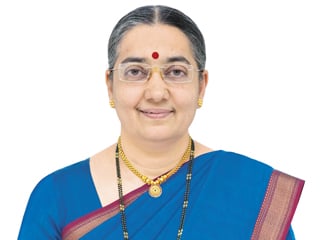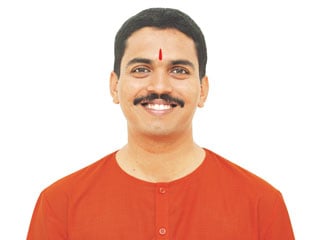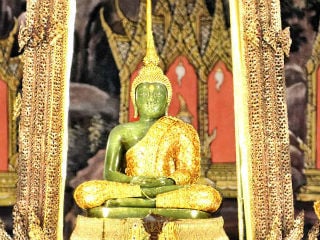Contents
‘The ‘Shyam desh’ of the olden days is Thailand of today. Several Hindu and Buddhist kings have ruled this land. Its culture was based on the Hindu Dharma but with passage of time due to cultural invasions of the Buddhists Buddhism became prevalent here. Here the king was accepted as a form of Prabhu Shriram and His capital was endowed the status of Ayodhya. Also the Holy text, the Ramayan is considered as the national literature. Shrichitshakti (Mrs.) Anjali Gadgil and four seeker-students toured Thailand from April 3 to 7, 2018. Now we will learn more about Ayutthaya, the ancient city of Thailand.

1. The Dwaravati dynasty (6th to 11th century)
This country is known as the ‘golden land’ because its king has uplifted Shyam Desh to the highest level
The Dwaravati dynasty ruled Shyam Desh from the 6th to the 11th century. The king of those days must have named the city Dwaravati from Dwarka the city of Shrikrushna in Bharat. During this era kings Suryavikram, Harivikram and Sinhavikram took Shayam Desh to its peak. Hence their subjects referred to the country as the ‘golden land’ which continues by the locals even today. The international airport at Bangkok, the capital of Thailand even today is known as ‘Suvarnabhumi airport’ (Suvarna means gold in Sanskrit).
2. The Khmer empire (11th to 14th century)
Suryavarman II of the Khmer dynasty attacked Shyam Desh from the 11th to 14th century and conquered some of its territory.
3. The Ayutthaya dynasty (14th to 18th century)
Shyam Desh known as Ayutthaya became Ayutthai and later Thai because of which it was named Thailand by the British
From 1351 to 1767 the Ayutthaya dynasty ruled. The ancient city of Ayutthaya existed on the banks of Rive Chao Phraya in the middle of Thailand. It is from here that the Ayutthaya dynasty commenced. Other countries associated with the Ayutthaya dynasty would refer to it as Shyam Desh while locals would call it Ayutthai. Later It came to be known as Thai and the British renamed it as Thailand. In 1767, after the Burmese invasion the entire Ayutthaya city was reduced to ashes. Several temples, Buddhist temples, palaces and libraries were destroyed. Now only its ruins remain (see picture 4) and UNESCO has accorded this ancient city the status of a world heritage structure.
 Wat Mahathat 1.Remnants of the ‘Wat Mahathat’ Buddhist temple in Ayutthaya city
Wat Mahathat 1.Remnants of the ‘Wat Mahathat’ Buddhist temple in Ayutthaya city
 Wat Mahathat 2. Sculpture of the face of Buddha placed in a hollow of the bark of the Bodhi tree in the vicinity of the temple
Wat Mahathat 2. Sculpture of the face of Buddha placed in a hollow of the bark of the Bodhi tree in the vicinity of the temple
 Bang Pa-In Royal palace on the banks of River Phraya behind Shrichitshakti (Mrs.) Anjali Gadgil.
Bang Pa-In Royal palace on the banks of River Phraya behind Shrichitshakti (Mrs.) Anjali Gadgil.
 (Ancient city : Ayutthaya) Ruins of the royal palace in the ancient city of Ayutthaya in Thailand
(Ancient city : Ayutthaya) Ruins of the royal palace in the ancient city of Ayutthaya in Thailand
 The Wat Chaiwattanaram temple constructed by the king of Ayutthaya
The Wat Chaiwattanaram temple constructed by the king of Ayutthaya

4. Wat Mahathat
King of Ayutthaya city constructed this Buddhist temple which at one point had several precious gems, ornaments and idols made from different precious stones
In the middle of Ayutthaya city are the ruins of a huge Buddhist temple ‘Wat Mahathat’ (wat means temple) (see picture 1). In 1374 King Boromarcha I built this temple and later King Ramesuanya expanded it. It is believed that this temple had several precious gems, ornaments and idols of nine precious stones. A sculpture of the face of Buddha has been placed by a sculptor in the hollow of the bark of a bodhi tree. Tourists flock to see this place (see picture 2).
5. Wat Ratchaburana
King Boromarcha II built a Buddhist temple to the north of Wat Mahathat in 1424 and named it Wat Ratchaburana. Sculptures of Garud (the eagle), the vehicle of Deity Vishnu attacking serpents are found on the outer walls of this temple.
6. Wat Bang Pa-In Royal Palace
A palace built over a sprawling area of 46 acres by the King of Ayutthaya was renovated by the king of Krim dynasty from Thailand in 19th century
Prasad Thong a king from the Ayutthaya dynasty in 1632 constructed a palace named Bang Pa-In 20 kilometers away from Ayutthaya on the banks of River Phraya in a village called Bang Pa-In from which it derives its name as Bang Pa-In royal palace. Spread over 46 acres of land this palace has libraries, guest chambers, tombs of ancestors, lakes and gardens in addition to chambers for members of the royal family. This king had four queens with a beautiful palace for each queen. In the 19th century, with assistance from China and France, King ‘Rama IV’ belonging to the Chakri dynasty of Thailand renovated this campus because of which today it stands with splendour like a new construction (see picture 3).
7. Wat Chaiwattanaram
Inspired by the Angkor Wat temple the king of Ayutthaya constructed a temple with seven peaks resembling Mount Semeru
In 1630, Prasad Thong, a king from the Ayutthaya dynasty inspired by the Angkor Wat temple built by the Khmer dynasty in Cambodia, built a temple to the south-east of Ayutthaya city. Like the Angkor Wat temple, it has seven peaks symbolising Mount Semeru. Built on the banks of River Chao Phraya from this temple you can travel by boat to other places (see picture 5).
8. Temple of the weeping Buddha
In memory of his wife, the king of Ayutthaya built a temple of Buddha from whose eyes tears began flowing and the popular belief that when the weeping of the idol stops crisis is on its way
There is a Buddha temple on the banks of River Phraya near Ayutthaya city, which is called as the ‘temple of the weeping Buddha’. It is believed that in 1881 when Queen Sunandakumari Ratna, the wife of King Chulalangkarnya was returning from China to meet the king, on her way towards Bang Pa-In palace, her boat capsized in the river. The heartbroken bereaved king installed a huge idol of Buddha on the banks of the river in her memory. The king noticed tears flowing from the eyes of this idol. Since then the people refer to this Buddha as the weeping Buddha. For several years tears continued to flow from the eyes of this Buddha which have stopped in the past few years. Our tourist guide told us that ‘this is an indicator of the impending times of crisis’.
– Mr. Vinayak Shanbag, Thailand (April 2018)

 Special features of the royal palace in Bangkok, the capital of Thailand
Special features of the royal palace in Bangkok, the capital of Thailand